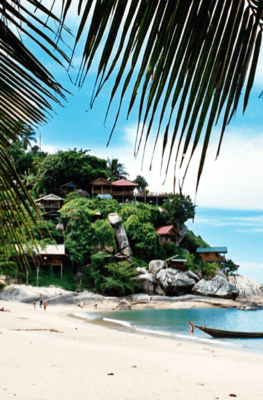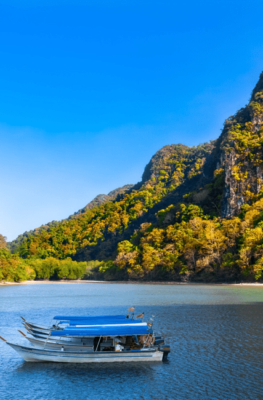Published on February 15, 2023
The Southeast Asian nation of Myanmar is rich in history, nature, and culture. Known as Burma until 1989, this unique country — bordered by the Andaman Sea and the Bay of Bengal — is dotted with lush mountains, gorgeous pagodas, and pristine beaches. The area that is now Myanmar was first populated in the ninth century and then ruled by various dynasties; the British seized control in the 1800s until the country regained its independence in 1948. Myanmar is the largest country in Mainland Southeast Asia — meaning that it is a veritable treasure trove of natural wonders. Continue reading to learn more about five of the most incredible natural wonders of Myanmar.
Inle Lake
Floating gardens at Inle Lake | Visit Southeast Asia
Serene, bountiful, and diverse, Inle Lake is one of the most famed natural wonders of Myanmar. This 116-square-kilometer lake is the second-largest in the country. It is known for its above-water bungalows, lakeside markets, canoeing fishermen, and — of course — its unique floating gardens. These floating gardens are all man-made, and each grows crops like tomatoes, beans, cucumbers, and gourds. Inle Lake’s fishermen themselves are also famous for their difficult, one-legged stance.
Part of the magic of Inle Lake lies in its rich cultural heritage. Despite the diverse ethnicities of local residents, most are devout Buddhists, giving rise to important local sites such as the Hpaung Daw U Pagoda. Other traditional practices in the area include silversmithing and weaving; visitors can observe these processes and purchase some wares of their own at five different markets around the lake or even at the occasional floating market on small boats out on Inle Lake itself. Popular goods don’t just end at silver and cloth: local artisans also specialize in rice wine, cheroots (a type of cigar), and carvings.
Located a short flight away from Myanmar’s largest city, Yangon, Inle Lake is an easily accessible natural — and cultural — wonder, perfect for gaining a deeper understanding of Myanmar itself.
Ngapali Beach
Ngapali Beach | Visit Southeast Asia
Ngapali Beach is a gorgeous, untouched stretch of land in western Myanmar, known best for its laid-back energy, high-quality seafood, and sheer beauty. Its closest town is Thandwe, about an hour’s flight away from Yangon. Ngapali is a soothing escape from the world, offering visitors the opportunity to swim, sail, snorkel, kayak, and more. The sunsets at Ngapali Beach are especially spectacular, given its location.
The seafood at Ngapali is known for being über-fresh: freshly caught tuna, barracuda, squid, and shrimp are all served at local restaurants. The beach is also dotted with resorts and hotels, making it a prime destination for visitors looking to relax.
Off the coast of Ngapali Beach is Pearl Island, which can be reached by snorkeling excursion or boat. This small island is even home to a restaurant called Lobster Bar. Whether you plan to snorkel through the mangroves or tan on the sand, Ngapali is the ultimate relaxation destination. It’s certainly no wonder this beautiful beach is one of the top natural wonders of Myanmar.
Irrawaddy River
A dolphin in the Irrawaddy River | Visit Southeast Asia
One of the most defining features of Myanmar, the Irrawaddy River, is a vital commercial and ecological hub. The name itself comes from an early Indo-European word meaning ‘abounding in riches,’ a fitting title for a river that is home to some 200 unique species of fish and that flows into the ultra-fertile Irrawaddy Delta region. It is also sometimes called ‘The Road to Mandalay,’ after an 1890 poem by Rudyard Kipling. As the river runs from north to south, it provides a base for everything from eclectic markets to wooden longboats to thick mangrove forests.
Along the Irrawaddy River are cities like Mandalay, Myitkyina, and Bhamo; Mandalay especially is worth a visit, as it was the last royal capital of the country. Other features of the Irrawaddy include pagodas, temples, bamboo villages, rice paddies, and much more. One of the most famous features of the Irrawaddy River, though, is the Irrawaddy dolphins, a grayish-to-slate-blue blunt-snouted species that populate the area. However, five of the seven subspecies of Irrawaddy dolphin are endangered due in large part to the presence of heavy fishing and boat traffic in many of its habitats.
No visit to Myanmar is complete without stopping by the Irrawaddy River — in the form of a river cruise, the sweeping view from a pagoda, or even a hot air balloon ride.
Hkakabo Razi
Hkakabo Razi | Visit Southeast Asia
The highest mountain in Southeast Asia, the 5,881-meter Hkakabo Razi, is part of Hkakaborazi National Park in the northern reaches of Myanmar. This mountainous, evergreen jungle region is fascinating for the climate disparity between its lower altitudes and its snow-capped peaks. The entire area is one of the most biodiverse in Myanmar, with a wealth of flora and fauna that ranges from sun bears and palm civets to clouded leopards and crested serpent eagles.
Very few professional mountaineers have summited Hkakabo Razi — the first ascent was in 1996, and the most recent was a National Geographic expedition in 2014. However, there is no need to climb the mountain itself to admire its wild beauty. Many treks and hikes in the surrounding park and the wider region begin in the town of Putao, which are perfect for those who love exploring the outdoors.
Anisakan Falls
Anisakan Falls | Visit Southeast Asia
Another destination in the northern hills of Myanmar, Anisakan Falls, is the most impressive waterfall in the country. Visitors can access the area by a 90-minute drive from the city of Mandalay. Its surroundings are made up of teak forests; the base of the waterfall is a 30 to 45-minute hike from the road. At over 121 meters high, this roaring waterfall is a sight to behold.
An elegant pagoda (pictured above) also sits at the base of the waterfall, and an elaborate gilded temple welcomes visitors at the entrance. Close to Anisakan is a small town named Pyin Oo Lwin, notable for its colonial architecture, cool temperatures, and flower gardens, so stop by the town after a visit to the falls for a taste of British colonial life.
Contact Us
Email us at aseantourismonline@gmail.com





